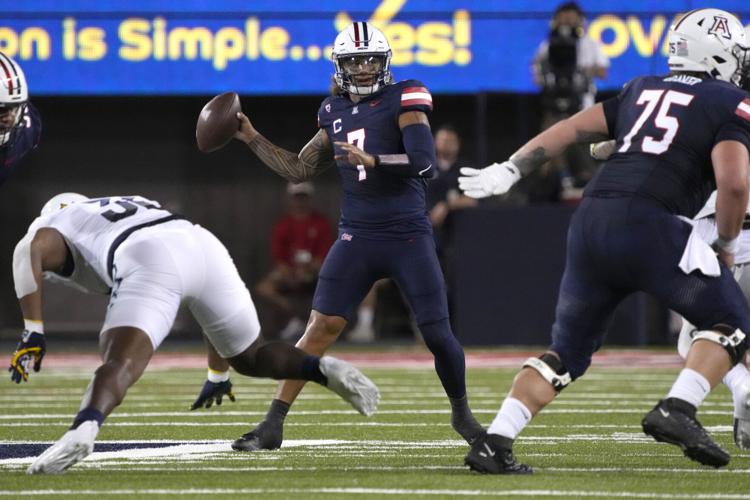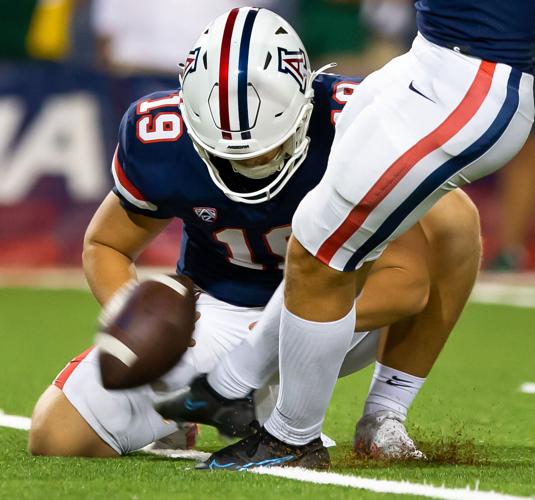One of the most unfathomable results in a wild college football season happened in Boulder, Colorado, on Friday the 13th. Stanford rallied from a 29-0 halftime deficit to defeat Colorado 46-43 in double overtime.
Afterward, Buffaloes coach Deion Sanders cited “complacency” as the primary reason for his team’s collapse. He could sense it going into the half, and it quickly manifested on the field. The Buffs thought they had the game won — and they didn’t.

Arizona has had to guard against that feeling since its 44-6 walloping of Washington State the very next day. After the opening drive, the Wildcats played close to a perfect game.
But Arizona’s coaches and most of its key players have been around long enough to know that the chase for perfection never ends. As third-year safety Dalton Johnson put it this week: “You can always get better.”
In that spirit, and as a follow-up to last week’s seven areas of growth/progress, we present five parts of the Wildcats’ game that have room for improvement in this Oregon State edition of “Cats Stats.”

Arizona quarterback Jayden de Laura (7) looks for a receiver against NAU during the first half of the Wildcats’ eventual victory over the Lumberjacks on Sept. 2 at Arizona Stadium.
Deep passing
It’s hard to find flaws in Noah Fifita’s performance over the past three-plus games, but this is one area where he’s missed the mark.
Fifita has completed only 4 of 13 passes thrown 20 or more yards downfield. His 30.8% completion rate is tied for third worst among Pac-12 passers with at least 66 overall attempts, according to Pro Football Focus. Fifita ranks next to last in yards per attempt on those throws (9.1).
Teammate Jayden de Laura ranks sixth in the league in completion rate on passes with 20-plus air yards (6 of 14, 42.9%). He was fifth in the league last year (32 of 82, 39.0%).
De Laura’s touchdown-to-interception ratio on those throws is just 1-2 — a reversal of last year’s 10-5. Fifita has two touchdowns and no picks on passes of 20-plus yards and only one turnover-worthy play, per PFF. So even though he’s missing more often than not, at least Fifita is keeping the ball out of harm’s way for the most part.
Overall, Arizona has only three pass plays of 40-plus yards, tied for 98th in the nation, per CFBStats.com.
Third-down defense
We’ve already reached the nitpicking portion of the program.
UA opponents have converted 38.46% of their third downs. If that mark holds, it would be the first time Arizona has held the opposition under 40% in a non-Don Brown season since 2013. (The Brown-coached defense posted a 37.41% mark in 2021.)
Still, the Wildcats rank just seventh in the Pac-12 in that statistic and 70th nationally. The best of the best — Georgia and Utah — have limited opponents to a conversion rate of less than 25% on third downs.
Arizona does appear to be trending in the right direction in this category. The Wildcats held USC and Washington State to a combined 35% (7 of 20). In the previous two games, against Stanford and Washington, Arizona yielded a conversion rate of 50% (13 of 26).
Takeaways
Similar to third-down defense, the Wildcats are just OK at taking the ball away but might be on the upswing.
Arizona has forced eight turnovers in seven games. That’s tied for 93rd nationally. The Wildcats’ two interceptions are tied for 127th. Only Temple (one) has fewer.
But there were signs of a possible turnover turnaround in Pullman. Arizona had a season-high three takeaways, including its first two picks of 2023. The Wildcats hadn’t forced more than one turnover in any of the previous six games.
UA coach Jedd Fisch believes that turnovers come in bunches. Arizona had two clumps of takeaways in its first season with Johnny Nansen as defensive coordinator — five in the first two games against San Diego State (two) and Mississippi State (three), and five in the finale vs. Arizona State. In between? Six in nine games, including four contests with none.
Three of Arizona’s final five opponents have excelled at protecting the ball. Utah, Oregon State and Colorado all have six or fewer giveaways, placing them right behind Oregon in the Pac-12. (The Ducks, remarkably, have only one turnover this season.)
The other two opponents, UCLA and ASU, have the most giveaways in the league. So the Turnover Sword should get some airtime down the stretch.

Arizona’s Turnover Sword lays on the ground following a turnover during the first half of the Wildcats’ game against North Dakota State at Arizona Stadium on Sept. 17, 2022.
Penalties
Arizona has been charged with 7.4 penalties per game. Only 13 teams have a higher average. (They include Pac-12 cohorts Washington, USC and Colorado.)
Those infractions have cost the Wildcats 61.4 yards per game, which ranks in the bottom quarter of the country.
Both of those figures are up from last season, when Arizona averaged 5.4 penalties and 50 penalty yards per game. The Wildcats were among the least disciplined teams in the nation, on the field, in Fisch’s first season, committing 8.8 fouls for 72.2 yards per contest in 2021.
Penalties were particularly costly in the USC game. Arizona had a season-high 12 for 99 yards, including some that extended drives and ended with the Trojans scoring points.
The Wildcats cleaned things up at WSU, totaling five fouls for 55 yards. They’ve had six or fewer — and 55 yards or fewer — in four of seven games. They’re 3-1 in those contests. When they’ve had eight-plus penalties and 60-plus yards in losses, they’re 1-2.
Special teams
Just to be clear, this doesn’t apply to all areas of special teams.
Placekicker Tyler Loop has had an excellent season, helping Arizona rank fifth nationally in touchback rate (85.37%). He also has made 9 of 11 field goal attempts, with his only misses coming from 45 and 50 yards.
Additionally, the Wildcats blocked a field goal that they returned for a touchdown vs. NAU.
But Arizona’s punt game has been inconsistent, and its return game has been nonexistent.

Arizona punter Kyle Ostendorp watches the ball as Tyler Loop kicks the extra point during the Wildcats’ Sept. 17, 2022, win over North Dakota State.
Kyle Ostendorp is averaging under 40 yards per punt (39.3), and Arizona’s overall gross average of 38.84 ranks 120th nationally. In net punting, the Wildcats rank 114th (36.21).
To his credit, Ostendorp has improved at placing the ball. He has dropped eight of his 18 punts inside the 20-yard line with only one touchback.
It’s the field flippers that have been missing. Ostendorp has only one punt of 50-plus yards. Last year, he had nine punts of 50-plus in 34 attempts. The year before, it was 28 of 58.
Despite having elite skill-position players, Arizona has yet to even come close to springing a game-changing return. The Wildcats rank next to last nationally in kickoff-return average (11.71 yards) and 127th in punt-return average (1.80).
Michael Wiley, who’s missed the past three-plus games, averages 19.3 yards per kickoff return with a long of 23. The coaching staff doesn’t seem to fully trust anyone else to do the job.
Punt returner Jacob Cowing has five returns for 9 yards with a long of 11.
No matter how fast or elusive you are, kick returns have to be set up right to succeed. Arizona hasn’t done that yet. It would be immensely helpful to figure it out with difficult but winnable games ahead. Any slight edge could make the difference.
Arizona head coach Jedd Fisch held a news conference on Monday to reflect on the bye week and look ahead to the Wildcats' matchup with No. 11 Oregon State on Saturday. Video by Justin Spears / Arizona Daily Star









